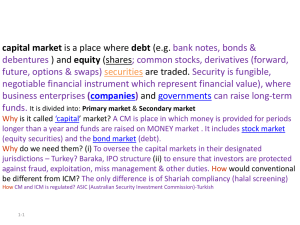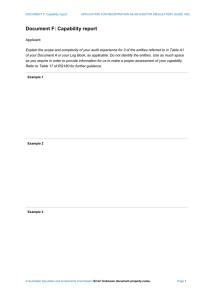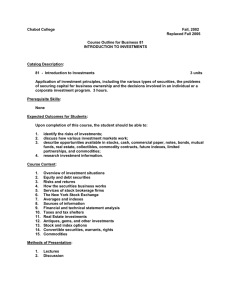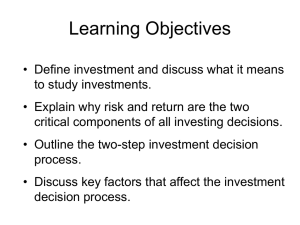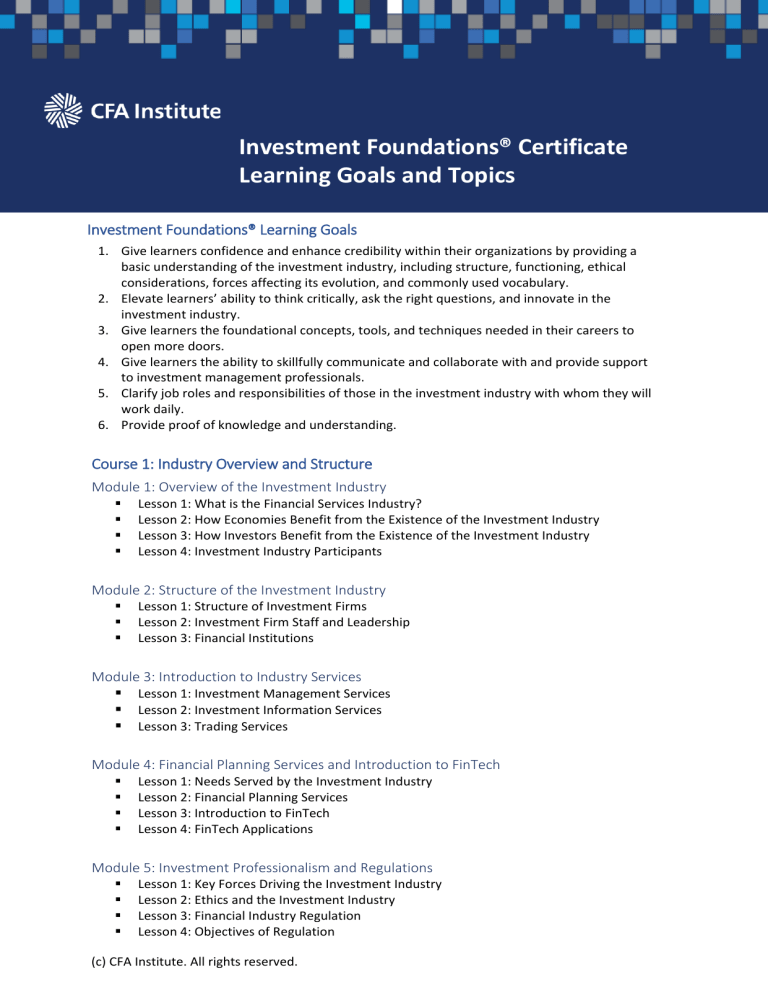
Investment Foundations® Certificate Learning Goals and Topics Investment Foundations® Learning Goals 1. Give learners confidence and enhance credibility within their organizations by providing a basic understanding of the investment industry, including structure, functioning, ethical considerations, forces affecting its evolution, and commonly used vocabulary. 2. Elevate learners’ ability to think critically, ask the right questions, and innovate in the investment industry. 3. Give learners the foundational concepts, tools, and techniques needed in their careers to open more doors. 4. Give learners the ability to skillfully communicate and collaborate with and provide support to investment management professionals. 5. Clarify job roles and responsibilities of those in the investment industry with whom they will work daily. 6. Provide proof of knowledge and understanding. Course 1: Industry Overview and Structure Module 1: Overview of the Investment Industry Lesson 1: What is the Financial Services Industry? Lesson 2: How Economies Benefit from the Existence of the Investment Industry Lesson 3: How Investors Benefit from the Existence of the Investment Industry Lesson 4: Investment Industry Participants Module 2: Structure of the Investment Industry Lesson 1: Structure of Investment Firms Lesson 2: Investment Firm Staff and Leadership Lesson 3: Financial Institutions Module 3: Introduction to Industry Services Lesson 1: Investment Management Services Lesson 2: Investment Information Services Lesson 3: Trading Services Module 4: Financial Planning Services and Introduction to FinTech Lesson 1: Needs Served by the Investment Industry Lesson 2: Financial Planning Services Lesson 3: Introduction to FinTech Lesson 4: FinTech Applications Module 5: Investment Professionalism and Regulations Lesson 1: Key Forces Driving the Investment Industry Lesson 2: Ethics and the Investment Industry Lesson 3: Financial Industry Regulation Lesson 4: Objectives of Regulation (c) CFA Institute. All rights reserved. Lesson 5: Types of Regulation Lesson 6: Consequences of Compliance Failure Course 2: Types and Functioning of Markets Module 1: Types of Security Markets and Trading Venues Lesson 1: Primary and Secondary Security Markets Lesson 2: The Role of Issuers Lesson 3: Primary Market Transactions Lesson 4: Trading Venues Lesson 5: Market Structures Module 2: Order Processing and Opportunities with Decentralised Finance Lesson 1: Positions Lesson 2: Orders Lesson 3: Clearing and Settlement Lesson 4: Transaction Costs Lesson 5: What is Decentralised Finance (DeFi)? Module 3: Investment Vehicles: Pooled Investments, Exchange-Traded Funds, and Security Market Indices Lesson 1: Direct and Indirect Investments Lesson 2: Pooled Investments Lesson 3: Security Market Indices Lesson 4: Index Funds Module 4: Investment Vehicles: Hedge Funds, Fund of Funds, and Managed Accounts Lesson 1: Hedge Funds Lesson 2: Fund of Funds Lesson 3: Managed Accounts Course 3: Investment Instruments Module 1: Quantitative Concepts Lesson 1: Time Value of Money Lesson 2: Present Value and Future Value Lesson 3: Net Present Value Lesson 4: Time Value of Money Applications Lesson 5: Descriptive Statistics Lesson 6: Measures of Dispersion Lesson 7: Normal Distribution Lesson 8: Correlation Module 2: Introduction to Investment Instruments and Equity Securities Lesson 1: Introduction to Investment Instruments Lesson 2: Introduction to Equity Securities Lesson 3: Valuation of Common Shares Lesson 4: Risks of Investing in Equity Securities Lesson 5: Corporate Actions (c) CFA Institute. All rights reserved. Module 3: Debt Securities Lesson 1: Introduction to Debt Securities Lesson 2: Seniority Ranking Lesson 3: Types of Bonds Lesson 4: Bonds with Embedded Provisions Lesson 5: Valuation of Debt Securities Lesson 6: Risks of Investing in Debt Securities Lesson 7: Yield Curve Lesson 8: Comparing Equity and Debt Securities Module 4: Derivatives Lesson 1: Introduction to Derivatives Contracts Lesson 2: Uses of Derivatives Contracts Lesson 3: Key Terms of Derivatives Contracts Lesson 4: Forwards and Futures Lesson 5: Options Lesson 6: Swaps Module 5: Alternative Investments Lesson 1: Advantages and Limitations of Alternative Investments Lesson 2: Private Equity Investments Lesson 3: Real Estate Investments Lesson 4: Commodity Investments Course 4: Investment Inputs and Tools Module 1: Microeconomics Lesson 1: Introduction to Economics and Microeconomics Lesson 2: Demand and Supply Lesson 3: Market Equilibrium Lesson 4: Elasticities of Demand Lesson 5: Profit and Costs of Production Lesson 6: Market Environment Module 2: Macroeconomics Lesson 1: Introduction to Macroeconomics Lesson 2: Gross Domestic Product and the Business Cycle Lesson 3: Economic Growth Lesson 4: The Business Cycle Lesson 5: Economic Indicators Lesson 6: Inflation Lesson 7: Monetary and Fiscal Policies Module 3: Economics of International Trade Lesson 1: Imports and Exports Lesson 2: Comparative Advantages Among Countries Lesson 3: Balance of Payments Lesson 4: Foreign Exchange Rate Systems Lesson 5: Value of Currencies Lesson 6: The Foreign Exchange Market (c) CFA Institute. All rights reserved. Module 4: Financial Statements Lesson 1: Roles in Financial Reporting Lesson 2: The Balance Sheet Lesson 3: The Income Statement Lesson 4: The Cash Flow Statement Lesson 5: Links Between Financial Statements Lesson 6: Financial Statement Analysis Course 5: Serving Clients Needs Module 1: Investors and Their Needs Lesson 1: Types and Characteristics of Investors Lesson 2: Factors that Affect Investors’ Needs Lesson 3: Investment Policy Statements Module 2: Investment Management Lesson 1: Risk and Portfolio Diversification Lesson 2: Asset Allocation and Portfolio Construction Lesson 3: Passive and Active Investment Management Lesson 4: Market Inefficiencies Module 3: Risk Management Lesson 1: Definition and Classification of Risks Lesson 2: The Risk Management Process Lesson 3: Risk Management Functions Lesson 4: Operational Risk Lesson 5: Compliance Risk Lesson 6: Investment Risk Lesson 7: Value at Risk (VaR) Module 4: Performance Evaluation Lesson 1: The Performance Evaluation Process Lesson 2: Measures of Return Lesson 3: Benchmarks Lesson 4: Measures of Risk Lesson 4: Measures of Relative Performance Lesson 6: Alpha Lesson 7: Performance Attribution (c) CFA Institute. All rights reserved. Course 6: Serving the Greater Good Module 1: Environmental, Social, and Governance (ESG) Investing Lesson 1: Approaches to Responsible Investing Lesson 2: Factors in ESG Investing Lesson 3: The Benefits and Challenges of ESG Adherence Lesson 4: Investor Engagement and Stewardship Module 2: Diversity, Equity, and Inclusion (DEI) in Practice Lesson 1: Key Concepts in DEI Lesson 2: Bias Recognition and Mitigation Lesson 3: Best Practices and Success Metrics in DEI Lesson 4: Applying DEI Concepts in the Workplace Module 3 – Part 1: Professionalism Lesson 1: Trust and Stakeholder Obligations Lesson 2: Ethics and Standards of Professional Conduct Module 3 – Part 2: Ethical Decision-Making Framework Lesson 1: Benefits of Ethical Conduct and Consequences of Unethical Conduct Lesson 2: Ethical Decision-Making Framework (c) CFA Institute. All rights reserved.
